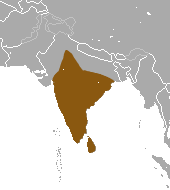Ruddy mongoose
Thank you for being part of the Bharatpedia family! 0% transparency: ₹0 raised out of ₹100,000 (0 supporter) |
The ruddy mongoose (Urva smithii) is a mongoose species native to hill forests in India and Sri Lanka.[1]
| Ruddy mongoose | |
|---|---|

| |
| Scientific classification | |
| : | [[Template:Taxonomy/Urva]] |
| Species: | Template:Taxonomy/UrvaU. smithii
|
| Binomial name | |
| Template:Taxonomy/UrvaUrva smithii (Gray, 1837)
| |

| |
| Ruddy mongoose range | |
| Synonyms | |
|
Herpestes smithii | |
DescriptionEdit
The ruddy mongoose's fur is brownish and coarse, long in hindquarters, but short in other parts of the body. Its head to body length is 40–45 cm (16–18 in) with a 36 cm (14 in) long tail. Males are larger and heavier than females with a weight of 2.2 kg (4.9 lb); females weigh about 1.2 kg (2.6 lb). Tail constitute about 75-90 % of body length. It is distinguished by the Indian grey mongoose by its slightly larger size and jet black-tipped tail.[2]
Distribution and habitatEdit
The ruddy mongoose is mainly a forest-living animal and prefers more secluded areas. It has also been recorded in secluded paddy fields and in comparatively open fields.[3]
TaxonomyEdit
Herpestes smithii was the scientific name proposed by John Edward Gray in 1837 for a zoological specimen in the collection of the British Museum Natural History.[4] All Asian mongooses are now thought to belong in the genus Urva.[5]
Subspecies:[6]
- U. s. smithii
- U. s. thysanurus
- U. s. zeylanius
Ecology and BehaviorEdit
It usually carries its black tipped tail tip curved upward which is visible from a distance. Like other mongooses, it hunts by day and by night,[3] and feeds on birds, rat snakes, land monitors, rodents and snails. Generally a solitary animal, rarely can be seen in pairs during mating season. However, mother and pup family groups consisting about five animals have been observed.[2]
It is found in thick jungles, forest edges near paddy fields and tea estates. However, withdraw quickly in a crevice or underneath a rock shelf during human confrontation. When cornered, they fight fearlessly with loud and shrill cries.[2]
In cultureEdit
In Sri Lanka this animal is usually regarded as an unlikable animal and a pest. The golden palm civet (Paradoxurus zeylonensis), altogether a different species endemic to Sri Lanka, is also called hotambuwa due to similar appearance and coloration.
ReferencesEdit
- ↑ 1.0 1.1 Mudappa, D. & Choudhury, A. (2016). "Herpestes smithii". IUCN Red List of Threatened Species. 2016: e.T41617A45208195.
- ↑ 2.0 2.1 2.2 Yapa, A.; Ratnavira, G. (2013). Mammals of Sri Lanka. Colombo: Field Ornithology Group of Sri Lanka. p. 1012. ISBN 978-955-8576-32-8.
- ↑ 3.0 3.1 Prater, S.H. (1971). The Book of Indian Animals (Third ed.). Bombay: Bombay Natural History Society. ISBN 019562169-7.
- ↑ Gray, J. E. (1837). "Description of some or little known Mammalia, principally in the British Museum Collection". The Magazine of Natural History and Journal of Zoology, Botany, Mineralogy, Geology and Meteorology. I (November): 577–587.
- ↑ "ASM Mammal Diversity Database". www.mammaldiversity.org. Retrieved 2021-07-08.
- ↑ http://www.wii.gov.in/envis/envisdec99/ruddymongoose.htm

